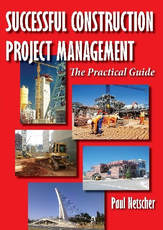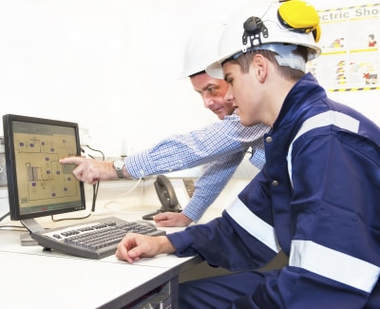 Image courtesy of Stuart Miles at FreeDigitalPhotos.net Image courtesy of Stuart Miles at FreeDigitalPhotos.net Are construction project managers contractually savvy? Many construction projects involve acrimonious legal fights over the contractor’s variation claims. Some of these battles drag on for months, even years, after the project is finished. They take a huge amount of time, effort and cost. Can these disputes be avoided? In my career I’ve been involved with over 120 projects in various roles, from site engineer, to project manager, project director, and general manager of the construction division. On almost every project we lodged variation claims for both cost increases and delays. 99% of these claims were settled with the client without resorting to outside intervention or legal help. In most cases we agreed amounts which were more than satisfactory for us. Sure, on some occasions we had to concede when we were wrong, once or twice we were beaten on a technicality, and sometimes we looked at the bigger picture on the project where it was beneficial to allow the client a win in return for the benefits of other claims we settled. Some of our contracts nearly doubled in value because of variation claims, and some had extension of times agreed of several months. Despite these many and sizable claims we remained on good terms with our clients and their team, continuing to be employed on their next projects. Now winning these claims was often vital for us, and without the wins many of the projects may have ended in a loss, or we would have finished beyond the original agreed project completion date which would have result in penalties or damages. I was personally involved with many of these claims, some claims were at my instigation, some I put together from scratch, many I provided input and advice to those preparing the claim, and most I argued the merits of the claim with the client’s team. So I find it alien that some project managers leave the preparation of variation claims entirely to their quantity surveyors, contract administrators, or other people in their team. Some companies even pass variation claims directly to external legal teams to put the claim together. Now I’m not saying that these people aren’t capable of preparing claims, but I believe that project managers should play an active part in the process. I’ve written several construction books, and I find it interesting that my book ‘Construction Claims: A Short Guide for Contractors’ sells the least copies of them all, and sells only one tenth, sometimes fewer, of the copies of my top selling book, ‘Successful Construction Project Management: The Practical Guide’. Now at first I was concerned that my claims book wasn’t great. I know that there are more detailed claims books on the market, but I tried to make my book an easy read that gave a general overview to variation claims. Fortunately the claims book has received some good reviews. So why are there so few sales? I realise now that having a better title may have helped! But looking at the other construction claims and construction contract books I’m surprised to see that they also sell as poorly as my claims book, while there are many general construction management books that sell equally well, even sometimes better than my top seller. Obviously reading books about variation claims is not high on the priority list for project managers. Is it because they are boring, maybe because project managers believe that they already have a good understanding of the topic, or because project managers believe that all contractual matters should be left in the hands of others? But, this is where many of the problems arise on construction projects. Why project managers need to be contractually savvy It is vital that project managers (site managers, construction managers, site agents) have a good understanding of variation claims.
I always enjoyed preparing variation claims, arguing their merits and winning the claims. I found it a very satisfying part of my job. Conclusion It is almost inevitable that projects will have changes and delays. It is vital that the contractor is compensated for these. However, no matter how legitimate the variation claim may appear to the contractor they must present the variation claim timeously, in accordance with the contract documents, and with all the supporting facts and documents. Contractors usually have only one opportunity to quantify the full time and cost impacts of the variation. It’s therefore vital that project managers read and understand the project’s contract documents, that they ensure that proper systems are in place to maintain accurate records, and that they take an active role in the formulation, preparation and the presentation of variation claims. These claims can be worth millions. It’s time that project managers brushed-up on their contractual knowledge. There are many valuable courses and books available. What do you think? Should project managers take an active role in preparing variation claims?  This article is adapted from information in the author’s popular books: 'Successful Construction Project Management: The Practical Guide' and 'Building a Successful Construction Company: The Practical Guide' and 'Construction Project Management: Tips and Insights' 'Construction Claims: A Short Guide for Contractors' is another of Paul's useful books. Paul has recently published 'Construction Management: From Project Concept to completion'. These books are available on Amazon and other online book stores. Paul publishes articles regularly on LinkedIn and his website. Paul writes regular articles for other websites, gives lectures, mentors, and is available for podcasts and interviews. © 2017 This article is not to be reproduced for commercial purposes without written permission from the author.
0 Comments
Will you know if your project is in trouble? This seems a silly question and many will answer that it’s obvious – a project is going badly when it’s running late and falling behind schedule and it’s losing money. Yet even when a project is finished late or loses money this is often only detected when the project is almost finished – when it’s usually too late to take corrective action. Yet these aren’t the only metrics that we should be judging a project’s success by. Recently a student wrote to me on LinkedIn to ask for help with a project that was looking at the parameters that would highlight when a project was distressed. He had decided that if the actual man-hours expended on the project were more than the planned man-hours it would be an indication the project was distressed. Now I explained that this was only one test, and it was a bit like going to a doctor and having your blood pressure tested. High or low blood pressure is indicative that there is a health problem, but having normal blood pressure doesn’t mean that you are healthy. In fact even if the blood pressure reading is high, there might not be a health problem, because there could be other factors giving the high reading, such as; the doctor didn’t carry out the test correctly, or you had just finished a session at the gym or were stressed because you had a job interview straight after the visit to the doctors. Indeed, whether a job is distressed, or going badly, would also depend on your relationship with the project. Different project stakeholders view the project outcomes differently, and it depends on the impacts on them. So for instance, a client might be far less concerned about the contractor losing money than the contractor would obviously be. But, the fact that the contractor is losing money is often a result of other factors which might eventually negatively impact the project for the client. Certainly, if the contractor loses so much money that they become bankrupt before the project is completed, then it should definitely concern the client – although many clients would ignore this potential problem until it was too late. Factors that could show your project is in trouble. There are a number of metrics that are critical to a project’s success. Some of these are early indicators that there is an underlying problem with the project.
 This article was first published on the ClockShark website. To visit this website and continue reading the article click on the link above. Please share this post To read more about the author’s books and find out where you can purchase them visit the pages on this website by clicking the links below: 'Successful Construction Project Management: The Practical Guide' 'Building a Successful Construction Company: The Practical Guide' 'Construction Claims: A Short Guide for Contractors' 'Construction Project Management: Tips and Insights' 'Construction Management: From Project Concept to Completion' 'Construction Book reviews' To read more about the author visit the page 'Paul Netscher' Want to contact Paul Netscher please enter your details on 'Contacts' Find out how Paul Netscher can help you Order your books from Amazon Order your books from Amazon UK © 2017 This article is not to be reproduced for commercial purposes without written permission from the author.  Image courtesy of Serge Bertasius Photography at FreeDigitalPhotos.net Image courtesy of Serge Bertasius Photography at FreeDigitalPhotos.net In construction, we depend on good people. Regrettably, there are many poorly skilled and unmotivated people in construction. Part of the reason is that sometimes people employed for construction projects are paid poorly, are transient workers, are poorly educated and have little motivation to stay in the industry. Construction is often not seen as a career of choice, and some end up in construction because that’s the only work they can get. Part of these problems is related to the cyclical nature of the construction business, with short cycles of plenty of work followed by sharp downturns when work is scarce. Society often places more emphasis on sports stars, lawyers and doctors, but, in general, tradespeople and contractors are looked down on. Being in construction isn’t easy with many construction projects working long hours, sometimes in adverse weather conditions. People are expected to work far from home and away from families. But, construction companies must also take some responsibility for poor quality employees. Contractors often employ the ‘wrong people’ focusing on cheap labor rather that the best person for the job. People aren’t trained, they aren’t trusted, they aren’t directed properly and some contractors take their employees for granted. Often Project Managers are focussed purely on the work at hand and don’t even notice others in the team. These employment practices could wreck your business
 This article was first published on the ClockShark website. To visit this website and continue reading the article click on the link above. Please share this post To read more about the author’s books and find out where you can purchase them visit the pages on this website by clicking the links below: 'Successful Construction Project Management: The Practical Guide' 'Building a Successful Construction Company: The Practical Guide' 'Construction Claims: A Short Guide for Contractors' 'Construction Project Management: Tips and Insights' 'Construction Book reviews' To read more about the author visit the page 'Paul Netscher' Want to contact Paul Netscher please enter your details on 'Contacts' Find out how Paul Netscher can help you Order your books from Amazon Order your books from Amazon UK © 2017 This article is not to be reproduced for commercial purposes without written permission from the author.  Image courtesy of Stuart Miles at FreeDigitalPhotos.net Image courtesy of Stuart Miles at FreeDigitalPhotos.net We are shaped by the way we were brought up, what our parents taught us and what we learned from our teachers and mentors. Many people are shaped by the history of their country, and some even bear scars and hate because of it. History can teach us many good things, but used incorrectly, or manipulated it can be damaging. Unfortunately even today, countries are prepared to go to war based on historical inaccuracies. So also in construction, how we did previous projects can serve as a valuable lesson, but sometimes it can be a hindrance. What we learned from our managers and the people that worked around us can serve as valuable experience, but sometimes it can also be detrimental. We always do it like this! Don’t you hate it when you propose a different construction method and someone says no, it’s not necessary to change, since we always do it like this? How quickly is innovation stifled! Sure the previous way may have worked – but was it the best solution? Anyway, are those methods appropriate to the new project? Every project is unique in many respects. We cannot automatically assume what worked before is the best solution now. Don’t let your history blind you, or indeed the history of another person deter you, or give you the wrong sense of how things should be done. What we can learn from history Our projects can supply much useful data, especially when it comes to pricing our next project. This data includes:
But is history always reported correctly? I’m sure the history most of us learned at school has changed? But how is this possible – history is history and can’t change? Unfortunately people view history from different perspectives, and the hero in one person’s version of history could be the villain in another’s version of the same historical event. Most history school books are distorted in some way to give the version of history that suits the current values and norms, which are often dictated by the government of the day. So too in construction, we have to understand how reliable the history is that we are getting. The history of past projects is often distorted by who is telling the story. After all, the project manager is always quick to blame the estimator for errors that were made in the pricing document which cost the project money. The estimator will blame the project manager for a poor project result. Project managers are quick to claim that they and the construction methods selected were the reason for a project’s success, when a large proportion of the success could be ascribed to the project price and schedule having ‘fat’. In fact, maybe the project could have been even more successful if other construction methods were chosen, if another more diligent project team had managed the project. Using that same project team, that appeared successful, on another project sometimes leads to problems which then surprise management. Of course the client’s team will blame the contractor when a project goes wrong when problems could be due to their own project team. Not understanding these problems could mean they are replicated on the next project. It is important that facts are recorded accurately so that there can be no debate about what went wrong and what mistakes were made. It’s important that systems are in place to monitor and record the health of a project. That reports and meeting minutes are accurate. That facts don’t get changed or go missing. But of course it is equally important to question and analyse the data that’s presented, so that inaccuracies are detected. Does what worked in the past apply to our situation? The Vikings won many battles with axes and swords, swiftly moving along rivers in their longboats. Well the strategy that worked (which was cutting-edge then) isn’t going to work today because the world has changed. We need to take what we learned from our past projects and apply them sensibly to our new project. We need to understand what’s different with our new project. Every project is different in some way, with a different; team, client, contract conditions, specifications, design details, weather conditions, topography, ground conditions, etc. Even the company’s circumstances may have changed, and of course things even change in the country with financial conditions varying and the availability of materials, skills and finance differing. We need to take what worked on previous projects and adapt it to suit the different conditions. Even identical projects probably won’t cost exactly the same!  Construction management books by Paul Netscher - available from Amazon Construction management books by Paul Netscher - available from Amazon Our teachers and mentors I feel sad for those new to the construction industry who have to rely on poor managers to teach them, managers who sometimes haven’t a clue how to manage a construction project properly. We often have the blind leading the blind. I was fortunate that I had many good managers, and also many good supervisors and foremen from whom I was able to learn. Sure, there were also poor managers, but I was able to use their example as how not to do things, because I had so many good teachers, examples and mentors. So there are many in the construction industry today, who have learnt poor methods from their history. Unfortunately, sometimes this is self-inflicted because a person chose to follow a bad example, instead of a good example. Sometimes we choose not to question those in authority, or we choose to believe those who are supposed to be teaching us. Often young recruits to the construction industry select who they work for based purely on salary, or where they can advance the most. They fail to understand the importance of working for a reputable company with good people and mentors, where they’ll get a sound grounding in the proper construction methods and practices. We don’t always have to be the victim of a poor history. We don’t have to be disadvantaged by our history. Always question if what you were taught is actually the best way of doing things. Always look for alternatives. Even be prepared to change companies to learn the correct way of doing things. Of course the older knowledgeable and experiences people owe it to the industry to pass their knowledge to the next generation. Conclusion It’s always important to learn from our past mistakes, even from the mistakes of others. Regrettably, we all make mistakes, we’ll all make the wrong decision sometime. The sad thing is when we don’t learn from these mistakes. But, we cannot accept that history is always right, or what worked on the last project will be the best solution on our next project. We have to be prepared to ask questions, to try new solutions. The history of our next project is in our hands. We owe it to those following to ensure that the facts are accurately recorded on our project. That when things go wrong that the blame is accurately apportioned – not so that those who caused the problem can be punished or victimised, but rather so that everyone can learn from the mistake and not repeat it again. The truth shouldn’t be hidden, nor should it be dressed-up as something it wasn’t. We need to ensure that we have reliable reporting systems in place and that the data inputted is accurate.
But when we use these facts in pricing our next project, or to plan our next project, we must understand not only the reliability of the historical facts, but also understand what is right for our new project, what is applicable and what should be used. We cannot be blind to the history of our past methods and projects, because there are often valuable lessons to be learned. But, we also cannot let this same history dictate the methods and planning of our new projects. We have to be open to new ideas and methods. So next time you decide on a construction method or action, ask yourself if your decisions are being influenced by history alone, or have you put real thought into selecting the best and most appropriate methods based on the current situation. Next time don’t be so quick to squash innovative ideas by saying we always do it like this or, it worked on our last project. Let’s also consider new technology and innovative solutions. Let’s always look at new ways to shape the future of our project. Our project does not have to be a victim of our history, but also let’s not make the same mistakes that occurred on other projects. This article is adapted from information in the author’s popular books: 'Successful Construction Project Management: The Practical Guide' and 'Building a Successful Construction Company: The Practical Guide' and 'Construction Project Management: Tips and Insights' 'Construction Claims: A Short Guide for Contractors' is another of Paul's useful books. Paul has recently published 'Construction Management: From Project Concept to completion'. These books are available on Amazon and other online book stores. Paul publishes articles regularly on LinkedIn and his website. Paul writes regular articles for other websites, gives lectures, mentors, and is available for podcasts and interviews. © 2017 This article is not to be reproduced for commercial purposes without written permission from the author.  Image courtesy of Serge Bertasius Photography at FreeDigitalPhotos.net Image courtesy of Serge Bertasius Photography at FreeDigitalPhotos.net Construction companies are constantly dealing with very complex projects that require intricate and thorough planning to ensure they are executed and completed successfully. Therefore, project management should be a crucial part of every construction project as it helps team members understand client expectations in the beginning and deliver accordingly once the project is in full swing. For that to happen, they require effective communication and collaboration, which is something that good project management can make happen. A construction project manager needs to plan, organize, schedule, coordinate and supervise projects, as well as take care of the budget so that every task can be completed seamlessly and effectively. Here’s how construction companies are using project management software to plan, build and manage complicated projects. Initiating the Project Initiation is the most important part of every construction project, as it includes determining whether a project is feasible. A construction project manager, together with the stakeholders, needs to create the business case for the new project and go through every possible detail to evaluate whether it represents a good opportunity. A feasibility study is often designed for everyone to be sure that they should move forward with the project. If the conclusion is to start the project, they create a project initiation document that outlines the business case and the entire plan for the construction. Planning the Project The planning phase of the project is crucial as in this stage a construction project management plan is created that every team member must follow. Apart from scope documents that outline goals, objectives, deliverables, schedule, costs, and all the resources, the plan needs to contain a visual representation of the project that will provide everyone with a checklist for the tasks to be completed. This is called a work breakdown structure (WBS), and its purpose is to break the project into small, easily digestible chunks. During the planning stage, a project manager should also create a risk management plan for more effective risk mitigation. A communication plan is created so that everyone can stay on the same page and work together towards achieving the common goal.  Image courtesy of stockimages at FreeDigitalPhotos.net Image courtesy of stockimages at FreeDigitalPhotos.net Executing the Project After making the construction project management plan construction can begin. The project manager makes sure that the proper resources are assigned to the project and that the tasks are executed properly. They also make sure that the schedule is followed and regularly updated. Monitoring the Project The project manager must monitor the project progress to make sure that everything is going smoothly and that every construction worker’s performance is at the highest possible level. Apart from controlling the project’s progress, they also need to work closely with the stakeholders, especially those responsible for the safety at the construction site. Completing the Project When the construction project is completed, the project manager creates the construction project report. They evaluate everything that was completed and analyze and evaluate mistakes and failures as well as the successes. If anything was left, it is evaluated as well, after which the final budget is calculated. Harnessing the Power of Project Management Software
If you want your construction company to be successful, you cannot rely only on paper documents and Excel sheets to plan and manage your projects, especially when it comes to very complicated ones. You need to use tools that will enable you to turn your projects into successful ones, which is why you need to utilize project management software. This software will help you with scheduling and with eliminating potential risks that may occur during the construction. Among numerous features, one of the best ones is the option for creating Gantt charts, which provide you with a clear insight into your project and helps you allocate resources, assign tasks and meet all your deadlines. You can also create task dependencies, which will save you time, and you can track time on your projects, so that you know exactly how long every task will take. With project management software, you can better organize your activities and even get real-time snapshots of them, so that you can effectively monitor the construction work and make better decisions, especially when something needs to be done quickly. The allocation of resources is very simple with this software, as the features provide transparency, so that everyone knows what they are responsible for and when they should perform their assigned tasks. Project reports and financial summaries can be created with just a few clicks, which saves considerable time (time which is often in short supply). Perhaps the most notable features of project management software are communication and collaboration features. Without these, construction projects might not be as successful as should be. The construction team needs to be able to seamlessly work together towards achieving the project goals. They need to be able to communicate in real-time, not only among themselves, but also with clients and other companies. This software enables them to do so, as it is cloud-based, where every piece of information can be accessed anytime and anywhere. This kind of faster collaboration leads to better decisions and helps with making every effort pay off. As you can see, construction companies can benefit considerably from utilizing simple project management software. If you are thinking about getting one, make sure that it is cloud-based, that it easily integrates with other types of software that you are already using or plan on using, that it has an intuitive interface and enables you to easily collaborate with multiple teams, and, most importantly, that it is reliable. Author Bio : David is a technical writer, his works are regularly published in various papers and top-notch portals. His rich experience in Project management domain helps him offer latest and fresh perspective on improved efficiency in work flows across organizations. His informative works on similar lines can be reached out on ProProfs Project. 
The latest book from Paul Netscher is essential reading for project owners, those planning a new project, project managers and principle agents.
Many construction projects are doomed to fail long before construction even begins. They are the wrong project, built in the wrong place at the wrong time. The design is inadequate, the budget is wrong, a poor team is selected and investigations are incomplete. Some projects are poorly managed and others aren’t finished properly. At any stage your project can go wrong if it’s not managed correctly! Filled with invaluable tips, insights and advice, this easy to read book takes you from project inception, where the owner decides what they want, where they want it and how much they can pay. To planning, appointing the project team, investigations, budgeting, the design process, selecting the right contractor, preliminary work, construction, and finally, commissioning and project completion. Chapters also cover project scheduling, important financial aspects and contractual arrangements. Whether you are planning to build a new home, preparing to renovate and extend your house, launching a new project as a seasoned property developer, perhaps a project manager who manages projects on a daily basis, or maybe you are just starting in the construction profession, you will find this book filled with valuable information to help you plan, monitor and manage each project phase to ensure your project is a success. Get your copy of this indispensable guide; Construction Management: From Project Concept to Completion, from Amazon and other online stores, available in paper or ebook. The author’s previous books have been favourably received by those new to the construction industry as well as seasoned professionals. Reviews include: “this is the best book on project management I have read” and “this book is fun to read and full of examples of what to be aware of with project management”. |
Archives
June 2024
Note: We welcome genuine comments, especially comments that add additional information to the subject matter in the article. We however reserve the right to remove inappropriate comments, which includes comments that have nothing to do with the subject, comments that include inappropriate language, and comments that are an advertisement for a product or company, or which include an advertising link. Comments must be in English. We will not enter into discussion on why a particular comment was removed.
CategoriesCopyright 2016 - The attached articles cannot be reproduced for commercial purposes without the consent of the author.
The opinions expressed in the attached articles are those of the writer. It should be noted that projects are varied and different laws and restrictions apply which depend on the location of the contractor and the project. It's important that the reader uses the supplied information taking cognisance of their particular circumstances. The writer assumes no responsibility or liability for any loss of any kind arising from the reader using the information or advice contained herein. "I have what I consider some of the best books on construction management."
Books are available from: Amazon.com Amazon.co.uk takealot.com kalahari.com Amazon.in Amazon.de Amazon.fr Amazon.it Amazon.com.au Powell's Fishpond uread bokus Amazon.ca Amazon.es Other retail stores Available in paperback or on Kindle "28 YEARS OF CONSTRUCTION PROJECT MANAGEMENT EXPERIENCE, DEVELOPING SUCCESSFUL CONSTRUCTION PROJECT MANAGERS AND BUILDING SUCCESSFUL CONSTRUCTION COMPANIES"
|






 RSS Feed
RSS Feed




